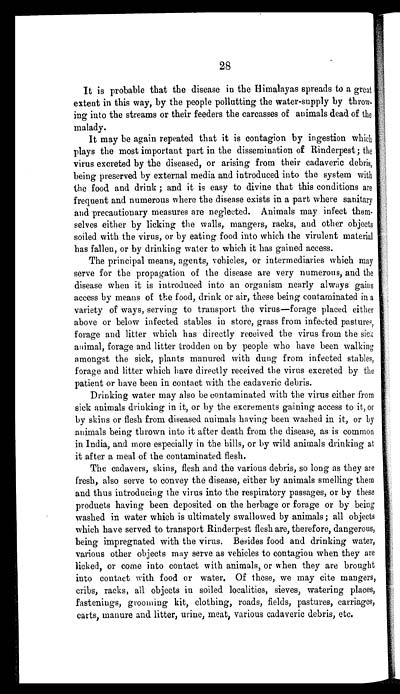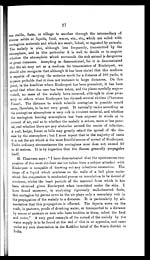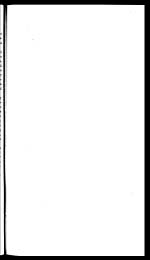Medicine - Veterinary > Civil Veterinary Departments > Civil Veterinary Department ledger series I-VI > Volume I - Rinderpest - cattle plague
(66) Page 28
Download files
Individual page:
Thumbnail gallery: Grid view | List view

28
It is probable that the disease in the Himalayas spreads to a great
extent in this way, by the people pollutting the water-supply by throw-
ing into the streams or their feeders the carcasses of animals dead of the
malady.
It may be again repeated that it is contagion by ingestion which
plays the most important part in the dissemination of Rinderpest; the
virus excreted by the diseased, or arising from their cadaveric debris,
being preserved by external media and introduced into the system with
the food and drink ; and it is easy to divine that this conditions are
frequent and numerous where the disease exists in a part where sanitary
and precautionary measures are neglected. Animals may infect them-
selves either by licking the walls, mangers, racks, and other objects
soiled with the virus, or by eating food into which the virulent material
has fallen, or by drinking water to which it has gained access.
The principal means, agents, vehicles, or intermediaries which may
serve for the propagation of the disease are very numerous, and the
disease when it is introduced into an organism nearly always gains
access by means of the food, drink or air, these being contaminated in a
variety of ways, serving to transport the virus—forage placed either
above or below infected stables in store, grass from infected pastures,
forage and litter which has directly received the virus from the sick
animal, forage and litter trodden on by people who have been walking
amongst the sick, plants manured with dung from infected stables,
forage and litter which have directly received the virus excreted by the
patient or have been in contact with the cadaveric debris.
Drinking water may also be contaminated with the virus either from
sick animals drinking in it, or by the excrements gaining access to it, or
by skins or flesh from diseased animals having been washed in it, or by
animals being thrown into it after death from the disease, as is common
in India, and more especially in the hills, or by wild animals drinking at
it after a meal of the contaminated flesh.
The cadavers, skins, flesh and the various debris, so long as they are
fresh, also serve to convey the disease, either by animals smelling them
and thus introducing the virus into the respiratory passages, or by these
products having been deposited on the herbage or forage or by being
washed in water which is ultimately swallowed by animals; all objects
which have served to transport Rinderpest flesh are, therefore, dangerous,
being impregnated with the virus. Besides food and drinking water,
various other objects may serve as vehicles to contagion when they are
licked, or come into contact with animals, or when they are brought
into contact with food or water. Of these, we may cite mangers,
cribs, racks, all objects in soiled localities, sieves, watering places,
fastenings, grooming kit, clothing, roads, fields, pastures, carriages,
carts, manure and litter, urine, meat, various cadaveric debris, etc.
Set display mode to: Large image | Zoom image | Transcription
Images and transcriptions on this page, including medium image downloads, may be used under the Creative Commons Attribution 4.0 International Licence unless otherwise stated. ![]()
| India Papers > Medicine - Veterinary > Civil Veterinary Departments > Civil Veterinary Department ledger series I-VI > Rinderpest - cattle plague > (66) Page 28 |
|---|
| Permanent URL | https://digital.nls.uk/75515963 |
|---|




